For the “Greatest Generation”, my parents’ young years, Shirley Temple was a mega-star. Between 1935 and 1938, from ages 7 to 10, she was Hollywood’s #1 box office star, but by age 22 she had retired completely from making films. She started acting at age 3 and by age 5 she had flowered into a major actress, singer and dancer. She could do it all and, by the standards of the time, she was a natural.
This early flower who blossomed at such a young age came to mind yesterday as Bill and I walked through woods and meadows. We saw many very early flowering plants already strutting their stuff in the cool spring breezes.
All around the yard the small, leafy rosettes of Pennsylvania Bitter Cress have already sent up tiny flower stalks. The four-petaled white flowers are often overlooked since they are so miniscule. Because of their plain design, they will never be stars in the flower world, but it’s worth kneeling to see these little gems against their backdrop of tiny leaflets (which are a great addition to a spring salad).
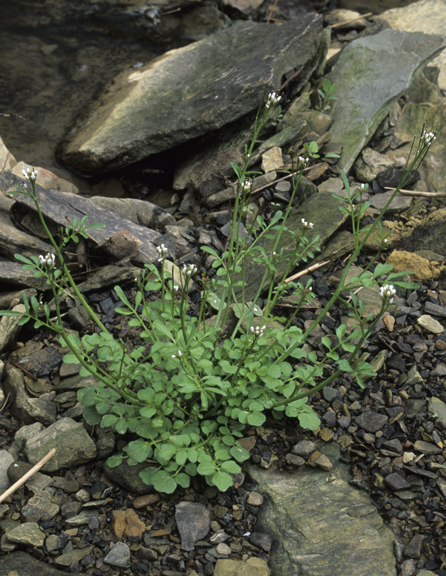
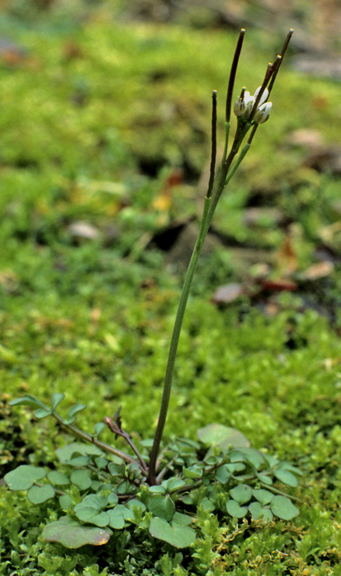
In a large “empty” flower planter, Bill spotted Purple Henbit just beginning it’s display. Ringing the stem is a circle of flowers — the first layer of flower rings which will build above each other like a flower apartment building. These showy flowers that no one ever sees rival orchids in their intricacy and beauty. The tiny tubes open upward into nodding hoods and lips in a variety of white to purple colors with deep magenta decorations splattered here and there. It takes magnification and, perhaps, muddy knees to get close enough to see the delicate loveliness of this undiscovered talent.
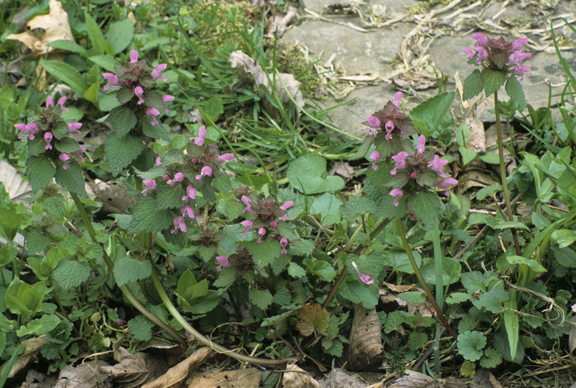
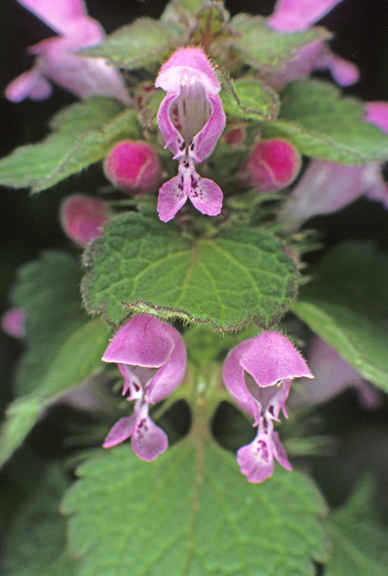
Down the hill, we knew the Skunk Cabbage was blooming on its wetland stage where, this time of year, it is the only actor. Although swampy areas may not be ideal for a spring walk, it’s worth donning high boots to examine this unique character. Next to the unrolling large leaves is the green and purple, pear-shaped piece with a top that gently curves over and around. This is what many people think of as the Skunk Cabbage flower. Actually called a spathe, it almost completely surrounds the thick round spadix on which bloom a number of very tiny flowers of the same off-white, gray-beige color. Like a play way off-Broadway, Skunk Cabbage flowers are not the easiest things to see, but are definitely worth the trip.

Of course dandelions can bloom in any month of the year…but be careful–what you see may not actually be a dandelion. This is the Coltsfoot time of year! It flowers so early along the road and driveway edges that the plant hasn’t even put out leaves yet. The large, hoof-shaped leaves will come later, but now the thick gray-green stems, rippled with stem leaves, reach up. The flower reminds me of a child’s drawing of a sun: dozens of long, thin, bright yellow petals seem to burst out from the center crowd of round stamens which look like the bubbly surface of the sun. Next time you think it’s just another smooth-stalked dandelion early in the spring, take a minute to look closer–you just may have a miniature sun on a leafy stem.
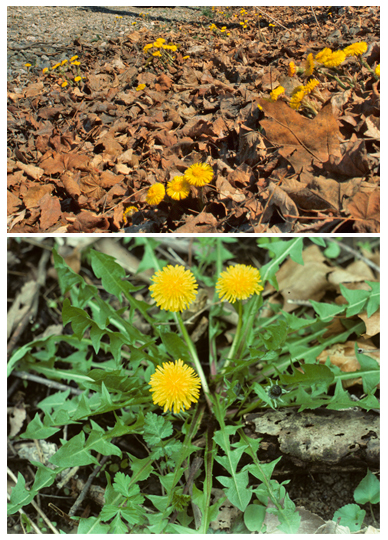

At first Sharp-lobed Hepatica flowers huddle in the woods with a bell-like shape, protected from the brisk spring winds by 3 green bracts. Soon this early-bloomer opens to show 6 or more long, rounded sepals (“petals” to most of us) of white to deep purple. Above the “petals” and a yellow pistil, the tall stamens look like a ring of bursting white fireworks celebrating the premier of the flower.
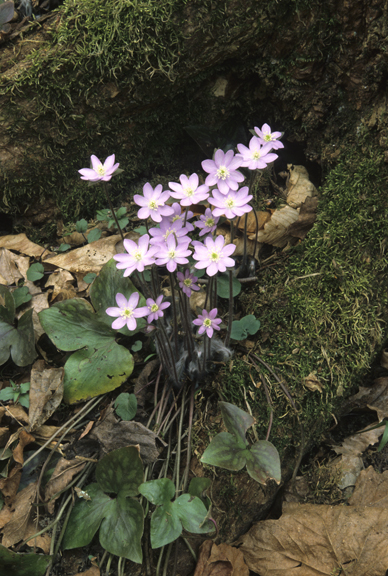
Also in the woods, the young Bloodroot flowers seem similarly protected from harsh spring weather by the large leaf wrapping almost totally around the bud. Eventually the stem grows beyond the leaf and the flower with a multitude of white petals and a sunny crown of bright yellow stamens stands proudly on the stage of early spring.
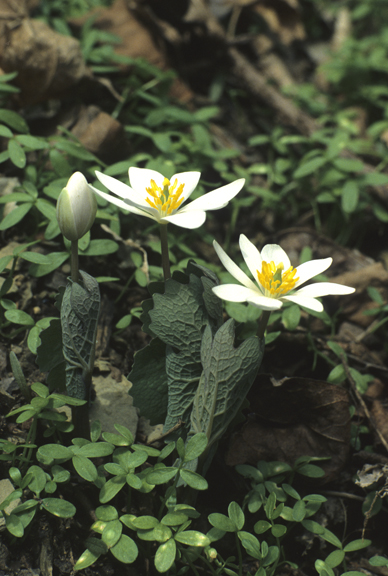
The first daring daffodil, while not a wildflower in this area, has already braved the cool weather to dance in the wind. It stands tall, looking as if it were singing in the sunshine spotlight.
Other plants are also starting their careers early, hoping a prompt start gives them an advantage. In open places in the woods, the ground is carpeted with bright fresh green Common Chickweed. As I found out two years ago in the garden, left unchecked, Common Chickweed will take over everything, doing a solo and keeping other plant actors out of the cast.
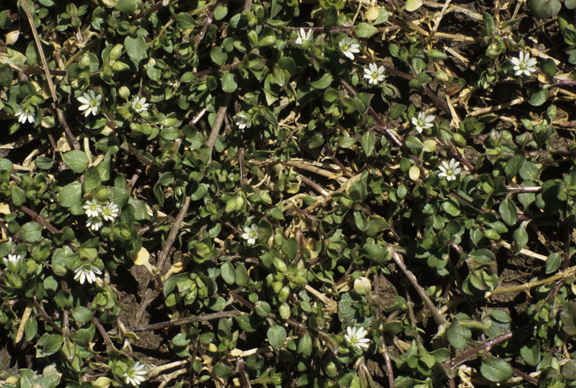
Tiny, exquisite flowers on our Red Maple are so early that they go almost unnoticed compared to super-stars like dogwood, apple and magnolia. When the tree just seems to have a reddish blush, I grab for a lower branch to examine it more closely. The multitude of long stamens beyond very tiny petals gives the flowers a fuzzy look. Most people have played with the winged samaras (“helicopters”, “whirlybirds”) that are the maple seeds, but few have seen where they originated.
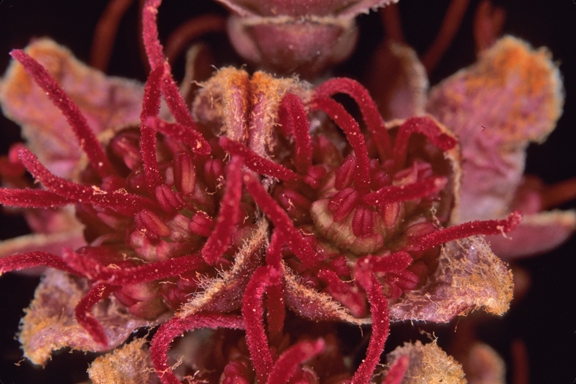
Also mostly unnoticed are the delicate flowers of the American Elm, now nearly past their season. Hanging down from the branches are the thin, long, green stems which end in petite flowers of white to pink. Spraying down from each flower are the white stems and large dark ends of the stamens reminding me of a two-layer firework display at the opening celebration for a new movie.
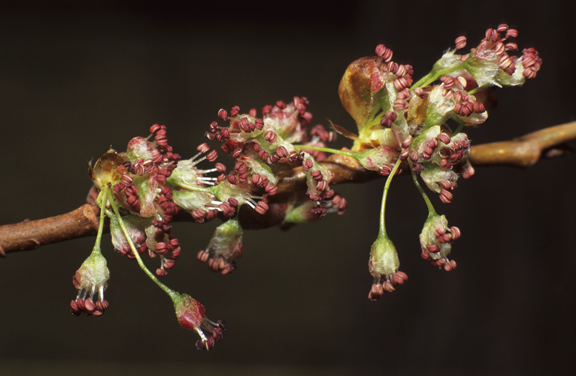
Like Shirley Temple, these flowers bloom early in the season, early in their young lives.
So many plants are growing, greening, and blossoming right now. Their visual chorus tells us that spring is here! But it’s like a tiny local theater production–beautiful and classy, but seen by almost no one.
Don’t miss out on Nature’s early spring pageant. The actors are dancing and showing off spectacularly right now, but soon they’ll be gone. Grab a coat, hat, gloves and hand lens. See the Shirley Temple wildflowers!
